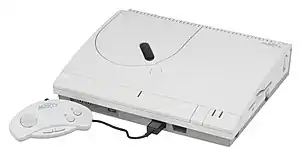FM Towns Marty
The FM Towns Marty[lower-alpha 1] is a fifth-generation home video game console released in 1993[3] by Fujitsu, exclusively for the Japanese market. It is often claimed to be the first 32-bit CD-based home video game system, although it has a 16-bit data bus, just like the earlier Commodore CDTV and Sega CD, which both have 68000 processors that is similarly internally 32-bit, but with a 16-bit data bus. The console came complete with a built in CD-ROM drive and disk drive. It was based on the earlier FM Towns computer system Fujitsu had released in 1989. The Marty was backward-compatible with older FM Towns games.
 | |
 FM Towns Marty console with controller | |
| Manufacturer | Fujitsu |
|---|---|
| Type | Home video game console |
| Generation | Fifth generation (32-bit/64-bit era) |
| Release date |
|
| Introductory price | ¥98,000 (then ~US$710)[1] |
| Discontinued |
|
| Units sold | 45,000 (as of December 31, 1993)[2] |
| Media | CD-ROM, 3½-inch floppy disks |
| CPU | AMD 386SX at 16 MHz |
| Memory | 2 MB |
| Display | 352x232 – 640x480 resolutions, 256 colors on-screen out of a palette of 32 768 |
| Sound |
|
| Backward compatibility | FM Towns |
In 1994 a new version of the console called the FM Towns Marty 2 (エフエムタウンズマーティー2, Efu Emu Taunzu Mātī Tsū) was released. It featured a darker gray shell and a new lower price (66,000 yen or 670 USD) but was otherwise identical to the first Marty. It is widely believed that the FM Towns Marty 2 would feature similar improvements to the FM Towns 2, which had a swifter CPU than the first, but this was not the case.[4] It has also been speculated that the Marty 2 featured a 486 CPU, however this was also discovered to be false.
There is also the FM Towns Car Marty (エフエムタウンズカーマーティー, Efu Emu Taunzu Kā Mātī) for installation in automobiles. It included a built in navigation system with audio and video guidance, and could also be detached from the car and played at home.[5] An optional IC Card for the FM Towns Car Marty allowed it to use VICS,[5] and was subsequently sold with a video monitor.
Reception
Despite having excellent hardware from a gameplay perspective, both the FM Towns and the FM Towns Marty were very poor sellers in Japan. They were expensive and the custom hardware meant expandability wasn't as easy as with DOS/V (IBM PC Clones with Japanese DOS or Microsoft Windows) systems. NEC's PC98 series computers were also dominant in Japan when the FM Towns Marty was released, making it difficult to break out before the DOS/V invasion took control of the market. This was despite such revolutionary features as bootable CD-ROMs and a color GUI OS on the FM Towns PC, something that predated Microsoft's Windows 95b bootable CD by seven years. Software today is rare and expensive due to the low production runs. Despite backwards compatibility with most older FM Towns PC games, compatibility issues plagued the Marty as newer titles were released with the FM Towns in mind, further limiting its potential as a true "console version" of the Fujitsu FM Towns PC. The Marty did have its own library of "Marty" specific games, but they were not enough to strengthen its niche position between video game console systems and personal computers.
When Fujitsu lowered the price and released the Marty 2 sales started to increase, but the corporate attitude was that it was a lost cause, and so the system was dropped. This led to the creation of the Japanese "Marty's Law" (マーティーの法則, Mātī no Hōsoku): if you don't keep offering something to sell, you can't increase sales.
Technical specifications
| CPU | AMD 386SX processor (32-bit) @ 16 MHz (3.6 MIPS[6]) |
| RAM | |
| Graphics |
The Marty had only composite and S-Video output, no other video connectors are possible. As some FM Towns games were VGA-only, the Marty had a 15 kHz down-scan capability for displaying on a household TV screen. |
| Sprites | Up to 1024 sprites, 16×16 pixels sprite size, 16 colors per sprite[10] |
| Sound |
|
| Data storage |
Floppy disks must be formatted 1.2M (PC98-style). This can be done from the BIOS GUI. The Marty's disk drive does not support standard 1.44M or 720k FAT formatted 3.5" floppy disks. For a PC to be compatible with FM Towns Marty floppies it must have a disk drive, BIOS and OS that supports "3 Mode". There are also USB floppy drives that support "3 Mode". |
| Multi-purpose | PCMCIA type 1 slot
The Marty's IC Card slot is compatible with type 1 PCMCIA cards, including battery-backed SRAM cards (accessible from the BIOS menu) that can be mapped to a drive letter and used as a small drive. Fujitsu also officially released a PCMCIA 2400 bit/s modem (FMM-CM301) for the FM Towns Marty. This modem was bundled with the special TCMarty that also came with a printer port. While it is widely believed that the IC Card slot can be used for RAM expansions, this is not correct. |
| Controllers |
The controller connector is a DE-9, referred to as an "Atari Type" in Japan because it's fundamentally the same connector as an Atari 2600. The Marty's Run and Select buttons are the equivalent of pressing right and left, or up and down at the same time. A six-button controller from Fujitsu was available for use with Capcom's Street Fighter II. Capcom also released an adapter for their CPS Fighter stick which made the stick compatible with the FM Towns/Marty as well as the Sharp X68000.[12] |
Games
Notes
- エフエムタウンズマーティー (Japanese: Efu Emu Taunzu Mātī)
References
- Die, 16-bit, Die! at
ign.com - 清水欣一『富士通のマルチメディア・ビジネス』オーエス出版社、May 15, 1995第1刷、March 14, 1997第4刷、ISBN 4-87190-415-6、151頁。
- http://www.videogameconsolelibrary.com/pg90-fm_towns.htm#page=reviews
- "FM Towns Marty Disassembly". Nfggames.com. 2007-08-12. Archived from the original on 2007-09-27. Retrieved 2016-06-24.
- "International News". Electronic Gaming Monthly. Ziff Davis (54): 92. January 1994.
- Enterprise, I. D. G. (25 March 1991). "Computerworld". IDG Enterprise. Retrieved 24 June 2016 – via Google Books.
- "ACE Magazine Issue 27". archive.org. Retrieved 24 June 2016.
- "OLD-COMPUTERS.COM : The Museum". old-computers.com. Retrieved 24 June 2016.
- "Edge Magazine - GamesRadar+". edge-online.com. Retrieved 24 June 2016.
- "Archived copy". Archived from the original on September 7, 2014. Retrieved October 17, 2014.CS1 maint: archived copy as title (link)
- "controls:capcompowerstick [NFG Games + GameSX]". gamesx.com. Retrieved 24 June 2016.
External links
- tripod.com/~faberp/: General information and pictures
- consoledatabase.com: Console Database entry
- nfggames.com: FM Towns Marty Disassembly
- gamesx.com: FM Towns Controller Connector
- xe-emulator.com: Xe, an emulator collection - domain appears to be squatted
- gamescollection.it: Fm Towns Marty games database
